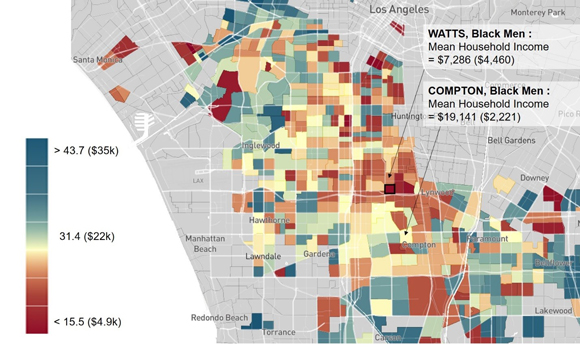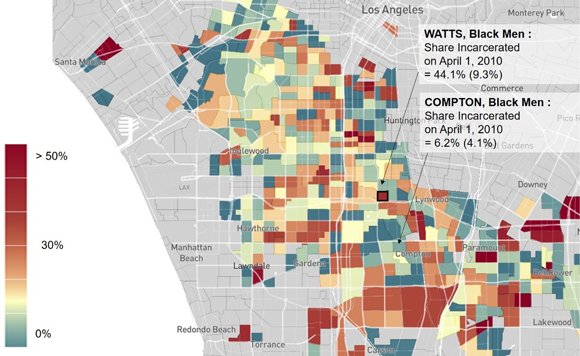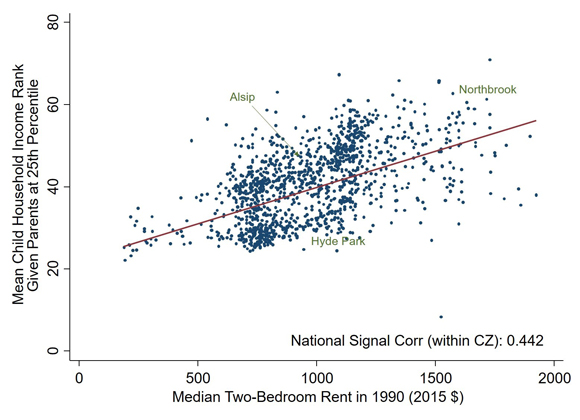The Opportunity Atlas
The Opportunity Atlas
How do children’s chances of climbing the income ladder vary across neighborhoods in America? Where is opportunity lacking and what can we do to improve opportunity in such areas?
In a new study, we construct a comprehensive census tract-level atlas of children’s outcomes in adulthood using anonymized data covering nearly the entire U.S. population. For each tract, we estimate children’s earnings distributions, incarceration rates, and other outcomes in adulthood by parental income, race and gender. These estimates allow us to trace the roots of outcomes such as poverty and incarceration to the neighborhoods in which children grew up.
All research results are provided in a new publicly available online data visualization tool, the Opportunity Atlas, available at www.opportunityatlas.org, where users can view the data for every census tract in America, overlay their own data points of interest, and export into a data set for their own analysis. Here, we provide a snapshot of this information and discuss some of its potential uses.
To build the atlas, we use de-identified data from the 2000 and 2010 Censuses linked to data from federal income tax returns and the 2005-2015 American Community Surveys (ACS) to obtain information on income, parental characteristics, children's neighborhoods and other variables. We focus on children born between 1978-1983, including those born in the United States and authorized childhood immigrants. Our data capture the characteristics of 20 million children, approximately 94 percent of all children born during the time period.
To construct the measures presented in the atlas, we first analyzed the relationship between child outcomes and the parent household income rank at the national-race-gender level. Some of the outcomes we examined include children’s income (averaged over 2014 and 2015), incarceration rates, and teen birth rates. At the tract-race-gender level, we regress child outcome (e.g., child income rank) on the predicted national value of the outcome for that child’s specific parent income percentile, race and gender. In the regression we include all children of the race-gender subgroup who spent at least one year of childhood in that tract.
To account for children who grow up in more than a single census tract, children are assigned weights in proportion to the fraction of their childhood spent in each tract. Using these regressions, we construct the predicted outcomes for children who grew up in the tract in families at five different points in the parent income distribution (p1, p25, p50, p75 and p99).
As documented in previous research on commuting zones (CZ), there is wide regional variation in intergenerational mobility based on the broad geography of where children grew up. Our new work finds significant variation even across census tracts within these commuting zones. The standard deviation across CZs of average household income conditional on having parents at the 25th percentile is $3,700. Figure 1 illustrates this variation for the Los Angeles regional area. Within the Los Angeles CZ, we find a standard deviation of about $5,400, illustrating an especially wide variation across neighborhoods within Los Angeles.
Figure 1
Our previous work also documents significant differences in outcomes across racial groups. To illustrate this, Figure 2 provides the estimates for black male individual income for those whose parents were at the bottom percentile of the parental income distribution. We again observe significant variation in individual incomes. For example, in Watts — the same tract as the Nickerson Garden Public Housing Project (census tract #242600) — low-income black males grew up to earn only $7,300 as adults. However, low-income black men growing up in nearby West Compton (tract #542700) earn $19,100 as adults.
Figure 2
We also find substantial heterogeneity across subgroups. The correlation in mean earnings for whites, blacks and Hispanics across tracts conditional on having parents at the 25th percentile is approximately 0.6. As result, places that have poor outcomes for one group do not always have poor outcomes for others.
This new tool has a variety of applications for local policymakers interested in reducing poverty and/or increasing mobility. Policies often either explicitly or implicitly target their intervention by geographic location. Such policies traditionally target large-scale intervention locations based on observed outcomes in an area such as poverty or crime rates. However, the atlas allows policies to be targeted towards areas where children grow up to have low incomes or a high likelihood of being incarcerated. We find that our new measures are only moderately correlated with traditional measures of neighborhood disadvantage, such as poverty rates (e.g. correlation of roughly 0.6 across tracts within CZs).
As a result, these new measures provide the potential opportunity to improve outcomes by targeting interventions in childhood, before adult outcomes are realized. To illustrate, Figure 3 documents the geographic concentration of incarceration in the Los Angeles area. Over 40 percent of black men growing up in low-income families in the Watts neighborhood are incarcerated on a single day — the day of the 2010 Census. This contrasts with neighboring Compton, for which only 6 percent are incarcerated. This variation at fine local levels suggests that precision policy targeting to the areas where these children are growing up could be effective for helping reduce incarceration and crime in adulthood.
Figure 3
Another application is in identifying opportunity bargains: neighborhoods that improve children’s outcomes but do not have higher housing costs. This provides potentially useful information both for families seeking neighborhoods with better outcomes for their children and policymakers looking to design affordable housing policies.
To illustrate the presence of opportunity bargains, we first explore the potential extent to which the variation across neighborhoods in the atlas reflects a causal impact of these neighborhoods on adult outcomes. To do so, we study the outcomes of children who move across tracts during childhood.1 We document that for every year a child spends in a tract where they are exposed to residents with higher outcomes, their own adult outcomes are higher. For children who move at age 5 to a place with 1 percentage point higher income ranks, we find they will on average have 0.8 percentage point higher income ranks in adulthood. In contrast, those moving at later ages on average have lower incomes. This suggests that the longer a child spends in a neighborhood with better outcomes, the higher his or her outcomes are in adulthood. Neighborhoods that produce higher incomes for children are not always more expensive. On average, the correlation is positive – Figure 4 shows the relationship between median rents based on the 2015 ACS and children’s household income at age 34 who grew up in those tracts.
Figure 4
Despite the positive correlation of 0.4, there is considerable variation conditional on rents. This suggests that there are many “opportunity bargains” that generate high outcomes for children but do not have higher cost of living. The evidence on opportunity bargains can in turn guide local policymakers on which policy-driven characteristics of neighborhoods appear to succeed in improving outcomes.
Conclusion
This Opportunity Atlas of outcomes based on the census tracts in which children grew up shows wide variations in incomes and other measures across neighborhoods within commuting zones. This newly available public data provides parents with information to help identify neighborhoods with better outcomes to raise their families and policymakers useful evidence to target place-based interventions with precision. More generally, we hope these maps are useful for understanding the childhood roots of economic success in adulthood.
1The methods and precise definition of causality are discussed in further detail in Raj Chetty and Nathaniel Hendren, “The Impacts of Neighborhoods on Intergenerational Mobility I: Childhood Exposure Effects,” Quarterly Journal of Economics 113 (3), 2018.







